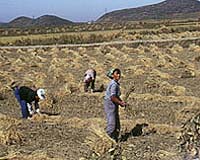| . |  |
. |
Paris (AFP) May 26, 2009 North Korea's claimed second nuclear test appears to have been a relatively small blast that is only a fraction of the size estimated by Russia, an expert said on Tuesday. "The yield is about four kilotonnes equivalent of TNT, with an uncertainty range from three to eight kilotonnes," Martin Kalinowski, a professor at the Carl Friedrich von Weizsacker Centre for Science and Peace Research (ZNF), at the University of Hamburg, told AFP. Russia had estimated the force of Monday's underground blast at up 20 kilotonnes, or the equivalent of 20,000 tonnes of TNT, which would have placed it in the same category as the 1945 Hiroshima bomb. Kalinowski said he was at a loss to explain how Russia had arrived at this figure. "I don't know how the Russians arrived at their high estimate," he said. "I haven't seen any technical evidence as to how they calculated this yield, no idea, but it's definitely wrong." Analysis of Monday's blast is based on data from seismographic sensors that measure shockwaves in the ground. But the only way to give "solid scientific proof" that the explosion was a nuclear one -- as opposed to a blast using conventional explosions -- is to get airborne samples of radioactive particles or rare gases that are typically vented from an underground blast, Kalinowski said. He added though that the location and size of the event stacked the odds firmly in favour of a nuclear blast. North Korea's first nuclear test, in October 2006, was also initially estimated by Russia at the equivalent of between five and 15 kilotonnes. Experts later downgraded it to one kilotonne or less -- a tiny yield that sparked frenzied speculation. One theory was North Korea had simply detonated a big pile of TNT in order to trick its enemies into believing it had joined the nuclear club. But this was later discounted when radionuclide evidence proved that the blast had indeed been a nuclear one. Another hypothesis was that the blast was a failure -- perhaps a larger bomb that had failed to go into a chain reaction. A third idea was that the North Koreans had ignited a miniaturised bomb. Kalinowski said that Monday's test was probably not a miniaturised device, as this is a technology that traditionally only established nuclear powers can master. "The four-kilotonne estimate hints that the explosion was not fulfilling the goal of North Korea completely, but it's not a big difference from the optimum yield that one could produce with a couple of kilogrammes (a few pounds) of plutonium," he said. "The first nuclear explosion was definitely too low compared to expectations. but this one I would say is OK. It's not optimum, but it's a big bang, it's a nuclear explosion and a strong one for a fission bomb." In terms of explosive power, hydrogen bombs and other thermonuclear devices are far bigger, "but they are second-generation weapons that North Korea clearly does not have and does not attempt," Kalinowksi said. "It's a first-generation fission nuclear weapon and that is about the size of yield that you would expect from such a weapon, a little less than possible, but with a pure fission device the yield anyway cannot be much higher than 10 or 20 kilotonnes." Share This Article With Planet Earth
Related Links Learn about nuclear weapons doctrine and defense at SpaceWar.com Learn about missile defense at SpaceWar.com All about missiles at SpaceWar.com Learn about the Superpowers of the 21st Century at SpaceWar.com
 NKorea, land of hunger, made nukes priority
NKorea, land of hunger, made nukes prioritySeoul (AFP) May 25, 2009 North Korea, which said Monday it had tested both a nuclear device and a short-range missile, has defiantly pursued its atomic ambitions even though it is unable to feed its own people. The country suffered famine for several years starting in 1995 which killed hundreds of thousands of people and left survivors subsisting on leaves, tree bark and whatever else they could find. Floods, fo ... read more |
|
| The content herein, unless otherwise known to be public domain, are Copyright 1995-2009 - SpaceDaily. AFP and UPI Wire Stories are copyright Agence France-Presse and United Press International. ESA Portal Reports are copyright European Space Agency. All NASA sourced material is public domain. Additional copyrights may apply in whole or part to other bona fide parties. Advertising does not imply endorsement,agreement or approval of any opinions, statements or information provided by SpaceDaily on any Web page published or hosted by SpaceDaily. Privacy Statement |